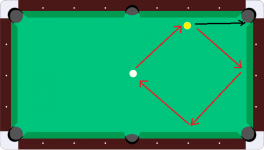Try this.
Use a LD shaft with BHE. Shoot the yellow (Yellow is one ball away from the rail) into the corner and have the c/b going three rails and back to the centre of the table (original position).
Let me know how it goes.
Ice,
You seem to be saying that you are having trouble applying more than one(1) tip of english using BHE with an LD shaft. I can certainly understand that if you are doing so under the exact premise of aiming for a 'normal' cut & then apply BHE. For instance in your example, given the closeness of the two(2) balls one might wind up hitting the ball too full.
I have used 'parallel' E, BHE, FHE, & combo B&FHE. I have found that even though BHE is supposed to be a 'mechanical' compensation for 'squirt', it still comes down to a matter of feel & even how one strokes the cue ball & the speed of the stroke. I have only been using LD sahfts for 8 months & to be honest I have a juiced, sanded down 314 Cat that I would never attempt BHE with as the swerve will almost always be more than the 'squirt' on any but the shortest of shots.
In other words, allow yourself to make small adjustments or try slightly different methods. For instance, if you realize that you wind up hiitting your example shot too full most of the time, you might want to set up for BHE but only go maybe 1/2 as far as you want & then add the rest by sliding your front hand the rest of the way. This will change the 'aim' of the shot, essentially adding cut to compensate for the the less 'squirt'. It may sound complicated & I quess it is a bit. But with use it becomes easier every time.
All that being said, you don't need all that much english. When I say english I don't refer to just 3:00 & 9:00. I hardly ever use those two(2). I might use 2:00 or 8:00 or less. In your example I would probably use 1:30 & try to get as much spin to speed ratio as I can. It does not require that much speed if you can get the spin. I use a soft tip for just that purpose.
Now all that being said, I'm working on CJ's method & I see that it can definitely work with much less mental & feel 'calculations'. But that shot, his way, for me, requires a firmer hit than I like or am comfortable with, but I'm getting there. I may have to switch to a firmer tip.
Sorry for the rant. I hope something in it helps you.
Regards & Shoot Well,

